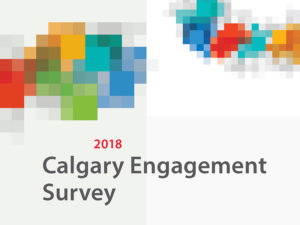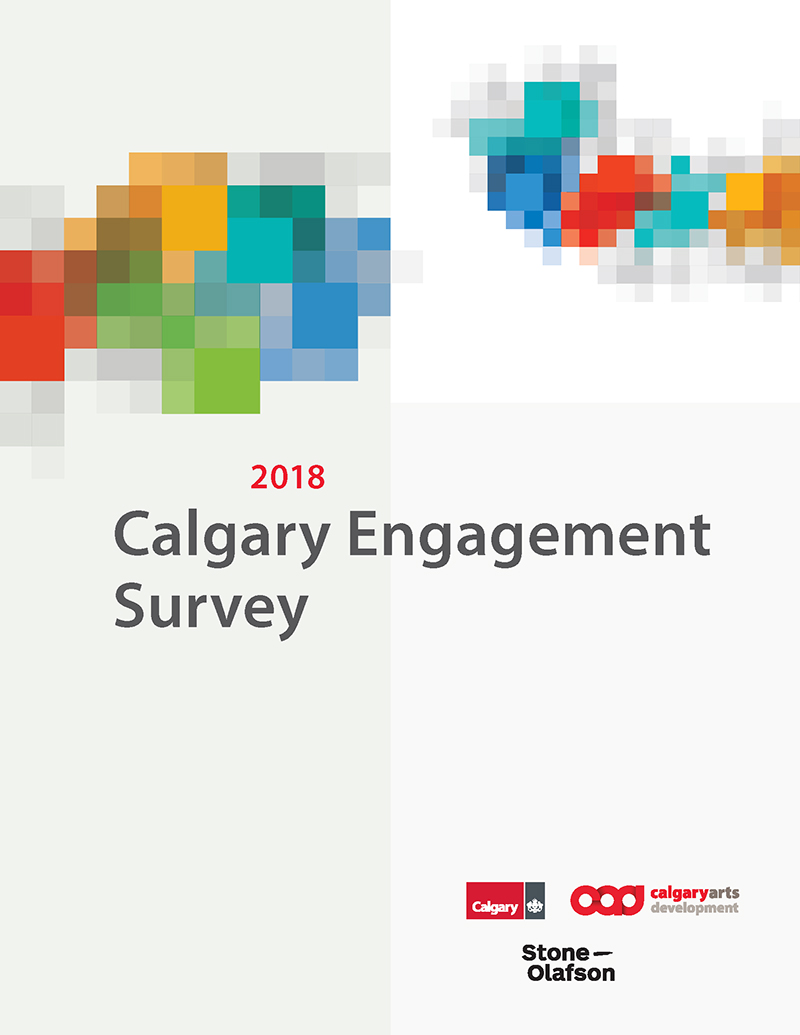Calgary Engagement Survey
How a community connects with the arts can be a clear indicator of vibrancy. In recent years Calgary has been experiencing a transformation. While economic uncertainty continues to frame the overall sentiment in the city, Calgarians continue to explore and find new ways to connect with the arts in their city.
This research is more than just a review of the degree to which citizens are engaged with arts & culture. Its purpose is to show how they connect and how they feel about it.
Observations
From the data emerge some key trends and findings. Calgarians continue to connect with and value the arts sector in our community.
Engagement with the arts remains strong
Overall, 93% of Calgarians are connected to the arts and culture sector in one way or another, a slight increase over the findings of the 2016 Calgarian Engagement Survey (92%). There also remains a significant proportion (75%) who are quite active—engaging in multiple ways.
Small shifts are happening that impact how the sector may engage Calgarians
Engagement is steady and attitudes are strengthening, yet attendance and spending have slipped slightly. This may be attributable to economic conditions, but may also be an opportunity for the sector to examine how it engages audiences in order to stem the trend.
Role of arts sector
Calgarians clearly recognize that the arts sector offers many civic, community and personal benefits. At the same time, local perceptions of how Calgary compares to other cities in this sphere have declined markedly. Is this the time to elevate the arts & culture sector to help differentiate our city?
How People Define Arts and Culture
Calgarians are generally aligned on a top tier of activities they consider to be representative of arts and culture. Art galleries, music festivals, live music, art shows, and live theatre are all mentioned. A second tier of other activities (museums, arts festivals, culture festivals, etc.) were also mentioned by a majority of the community.
Most Calgarians see and understand the benefits and are supportive of the arts, and generally acknowledge the impact on the quality of life in our community.
The current research has highlighted potential barriers to greater participation with various arts and culture
organizations in the city. Some important elements that may be contributing include:
Simple Awareness: Audiences may not be seeing the opportunities available to them. Arts organizations
have limited budgets to invest in creating broad awareness across the market.
Alignment of Expectations: Audiences are clearly interested and understand the benefits of the arts. However, their motivations to engage are generally fairly simple–to socialize and be entertained (primarily). Marketing and messaging from arts/culture groups need to take these motivations into account when communicating with potential audiences.
Practical Barriers: Our city’s current economic conditions have had an impact on consumer spending. While things have turned around modestly, consumer spending takes years to recover after a severe recession. This, combined with continued economic uncertainty, could be having a negative impact on attendance.
Further Understanding Definitions of Arts and Culture
Interesting outcomes arise when it comes to what defines art and culture. More specifically we learn that women, those over 55, and long-term residents are most likely to identify with the arts and culture activities listed. At the same time, older and longer-term residents of Calgary tend to be less engaged. The initial conclusion is that those who are most engaged tend to identify least with common activities associated with arts and culture.
Context has a role to play here. Much has been written about the importance of experiential elements with younger generations. This opens up new ways to think about future opportunities to engage younger audiences with more traditional arts and culture activities, perhaps by promoting the experiential elements or the promise of a unique experience.
Economic Impact and the Opportunity to Shift how the Sector Engages Calgarians
There is continued high engagement and very positive attitudes toward arts and culture. Yet, at the same time, there has been a slight decrease in attendance and slips in spending in the sector. The most obvious explanation for this gap is economic. As noted earlier the recession continues to play a role as consumer spending often takes years to recover to pre-recession levels. In Calgary, continued economic uncertainty has exacerbated the challenge and depressed spending in general, which continues to impact the arts and culture sector.
This raises an important opportunity for the sector to redefine how it connects and communicates with consumers. Are there key messages that better relate to audience motivations that should be emphasized? Should the sector consider simplifying its value proposition for the community? Along with increased marketing support, this may help deepen engagement with Calgarians.
Is Calgary More Creative and Artistic?
When asked how Calgary compares to other cities in terms of being artistic and creative, Calgarians are much
less likely now to say our city is more creative and artistic than they were just a few years ago. In fact, the
percentage who believe Calgary is better than Winnipeg has dropped 9%, Edmonton—down 12%, Toronto—down 6%, Montreal and Ottawa—down 2%. In no instance does a majority believe Calgary is more creative and artistic than any of these other communities.
Calgarian Engagement Survey Background
As the designated arts development authority, Calgary Arts Development supports and strengthens the arts to benefit all Calgarians. Through its many activities it supports organizations in their efforts to grow the sector and help forge even stronger connections with the community. Key to this is investing in understanding how the community perceives and engages with various arts events and activities.
Calgary Arts Development partnered with Stone-Olafson to better understand how Calgarians are engaging with arts and culture in our community. Specific objectives include:
- Monitor overall engagement with the arts in Calgary.
- Determine the type of engagement—either in observation, attendance or creation.
- Understand community perceptions and interactions with arts and culture activities/organizations.
- Evaluate citizen perceptions of the benefits of the arts and culture sector to the city, their community or themselves.
Research Methodology
The survey instrument and sampling plan were developed by Stone-Olafson in collaboration with Calgary Arts Development. The research was fielded online by Stone-Olafson using a consumer household sample with quotas established to ensure final outcomes are representative of the wider population in terms of age and gender.
Within the sample quotas were set to ensure representation by region within the city including Northwest, Northeast, Southwest, Southeast and Inner City.
The definition of inner city reflects the alignment of the City of Calgary’s Centre City Plan
A total of 1,004 Calgarians participated in the research between September 28 and October 17, 2018. A sample of this size delivers an overall reliability rate of +/-3.03%. Because the overall sample is representative in terms of age and gender final data have not been weighted.
Download the full publication:

